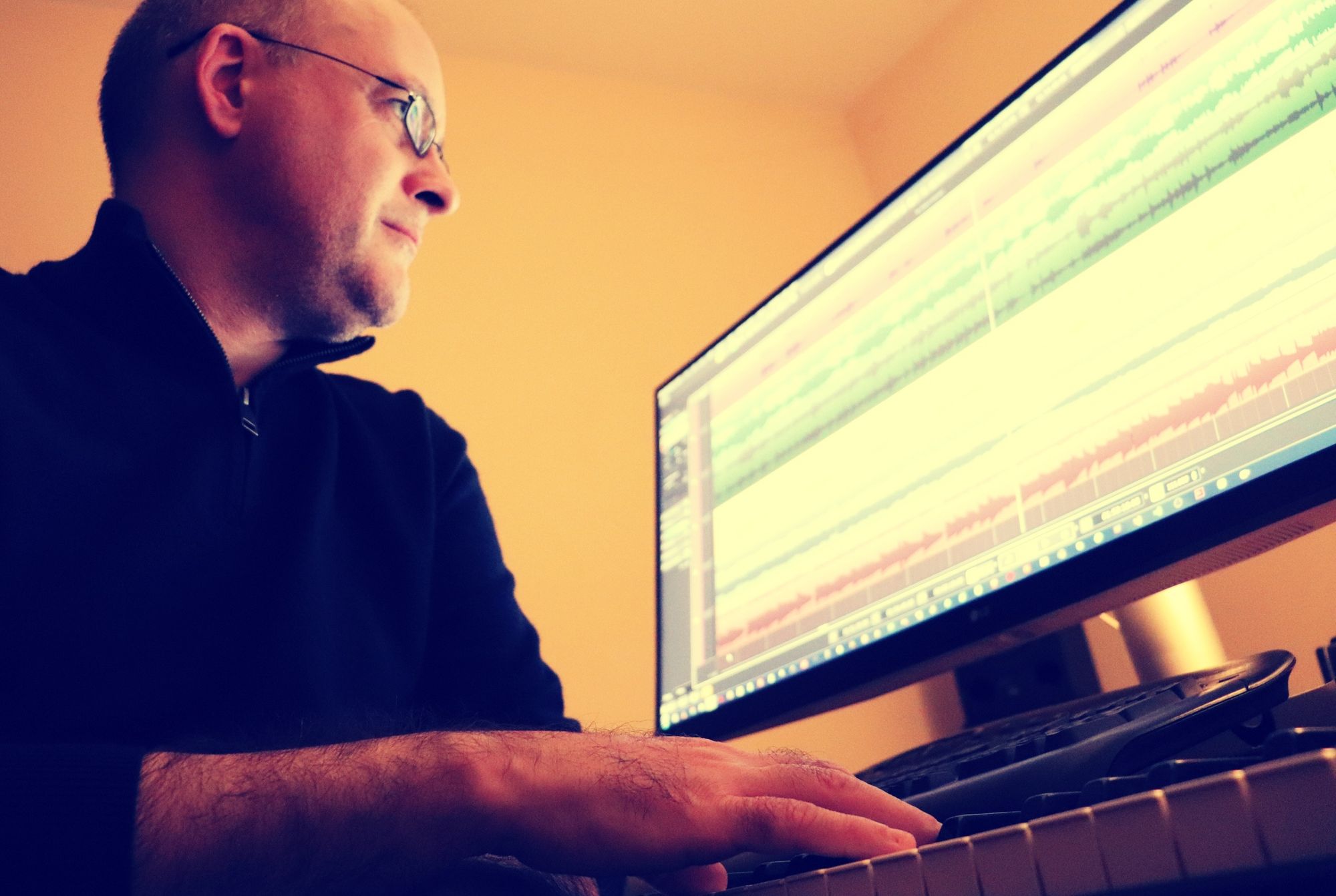
Writing Film Music with Composer Andrew Hewitt
Andrew Hewitt is a film composer with a background in classical performance. He holds a Masters in Music from Cambridge University and received a full scholarship to London's Guildhall School of Music and Drama. His film first score, for the cult series Garth Marenghi's Darkplace, earned him a BAFTA Nomination for the Anthony Asquith Award. Since then, Andrew has scored a wide variety of theatrical feature films that showcase his versatility and adaptability, and also TV that includes series, cult comedy, documentaries, commercials, animation, docudramas, and movies, across the U.S. and Europe. His latest feature film, It’s What’s Inside, is now on Netflix after a massive $17,000,000 sale at the 2024 Sundance Film Festival.
Andrew was gracious enough to talk to us about the emotional nature of film scoring, his process with directors, and what he wishes other creatives understood about composition.
Jessica Hobbs: Starting with a basic question: what’s your musical background?
Andrew Hewitt: I was a classical performer since I was a kid—a singer—then I went to Cambridge University for a Music degree, and lastly a year as a performer at the Guildhall School of Music and Drama in London. It’s a very classical background with no composition training. While I was doing that performing, I was falling in love with American films. I didn’t move here because it was convenient. I just love the American way, warts and all, but there’s something very special about American films. British films are different. There’s something a little less expansive.
There’s an emotional breadth to American films. They like taking daring choices in the characters’ behavior that they don’t in British films. Silence of the Lambs, one of my favorite films, never could have been made, in my mind, by a British director. You could argue about that forever, but there’s something unique that’s impossible to have been captured by another country. It’s just so beautifully broad.
So, I collected soundtracks avidly and listened to them around the clock. Then, some comedians from Cambridge Uni were making a comedy series that required a lot of music, and they wanted to work with people they knew and liked. That was 2004. So, after that, I phased the classical performing out, had six years of working in TV only, and then in 2009, I had my first feature, Cuckoo. I’ve done twenty features now.
JH: It’s interesting that a lot of composers start out as performers, studio musicians, or even rock stars before moving into composition and/or score production. When did you start feeling the pull to being a composer?
AH: This is a thing that you learn on the job. Just like acting or directing, you can only learn so much outside of doing it. It was something I developed in myself. So, when I did that first TV job, which required music scored throughout each episode, rather than just a theme tune, it was the best training ground. It was with a trusted friend, so not playing any social games, and we could communicate really easily. With that director, Richard Ayoade, I went on to do Submarine in 2010 and The Double in 2013. That was a very easy relationship.
It’s not just getting the chance, you’ve got to be able to do it and keep on doing it.
JH: How did you keep doing it?
AH: I don’t know! I don’t think anyone knows. It’s a mystery. You meet people, they see your stuff … I mean, most of my features have been people who have come to me because they’ve seen the stuff I’ve done. I’ve sent in demo reels before, but in the main, it’s been people going, “I liked what you did in that film.”
JH: You did the score for It’s What’s Inside, which is a brilliant psychological thriller that sold for an astonishing $17,000,000 at the 2024 Sundance Film Festival. How did you meet and come to work with its writer and director, Greg Jardin?
AH: Greg loves The Double, and he loves that score. He wrote me an email, and I didn’t even know him. He said, “I think you get ‘it,’ whatever ‘it’ is, what this film is about that I’m making.” He had a kind of intuitive connection that made me feel right for it—I think it’s the psychological games in both films that he was interested in. Then we chatted and found that we shared a sensibility and love of films.
It’s a weird thing to say, but not every composer is really into films. That’s fine, everyone’s different, but there are some composers, like me, who are addicted to films and find them really important. They love to do the best job that they can, not because it’s the job, but because they want to make a really good film.
It’s not because I want to be right, it’s because I want the film to be good. That really matters to me. They’re the most powerful artform we’ve got. So, it was very easy to talk with him, and that’s where it started.
JH: You took a really interesting approach with the score as well, starting with the fact that you and Greg were working on the score together from the very beginning of pre-production. That’s quite uncommon for composers; they are so often brought in after principle photography and work during the post-production process—or perhaps even after the picture lock. What’s the benefit for being involved during the whole process?
AH: Big question! It cascades through everything. It’s not linear, it’s like a web through the whole creative process. I told Greg that on The Double, I had started before they had shot anything, and he loved that idea.
You can’t score a script, so Greg talked to me a lot and developed a library of ideas in his mind that were painting moments in his film as he was envisioning it. He was able to start playing around with ideas way before he shot the film. Then, he played it to the actors on set, so they were put in the mood, sitting in rehearsals, reading the scripts, and listening to the score in their headphones. Then he played it on set, and he was the editor, so he was sitting in his den at home, putting the music in different places and experimenting—things that would have taken days to do, if he were going back and forth with a composer—and editing a lot of the scenes to the music.
A lot of the effects of the music, that rhythmic musical feel, are because he edited scenes to pre-existing music. Then about 25% of the score was going in after that, and I was doing new pieces or extensions of existing pieces. So, it was very fluid and smooth.
JH: How does that change things, financially, for a production? How involved are you in pre-production, and how does it affect a film’s budget?
AH: On different productions, you’ll get a different answer. But my general impression is that the composer gets a budget and is asked to make everything work within that, including their fee—the production of it, the maintenance of their home studio, etc. It takes the time that it takes.
I didn’t do anything during the shoot, it was a chunk before and a chunk after. It’s not done by the hour. You get a budget, and you’re asked to deliver it when they need it delivered. I’ve never heard of a composer being paid by the hour, unlike the engineers and sound mixers who can stop at 5:00. Composers will often get briefs AT 5:00! On a Friday! So, it’s not an hourly model, it doesn’t affect the budget.
JH: There’s a wonderful collection of interviews with composers who work specifically in horror movies called Scored to Death, written by J. Blake Fichera—in fact, there are so many interviews that there are two volumes of the book!—and Eli Roth wrote the introduction for the second installment. In the book, he says that he insists on bringing composers in at the beginning of the process. Hildur Gudnadottir, who won an Oscar for her score for Joker, also worked this way with director Todd Philips. In fact, during filming, Phillips and Joaquin Phoenix were struggling with what the main character should do after the first murder in the movie, and Phillips called Gudnadottir in to consult based on the mood of the score she had been writing. That’s when Phoenix improvised the bathroom dance scene.
AH: That’s lovely. That’s the kind of story that a lot of creative people remember from college, where there’s an easier collaborative spirit. There are actors who do their first project, and it’s so beautifully like that, and are surprised to learn other projects are not like that.
With the right director who invites that, anything is possible. But it has to be facilitated. The composer can’t say, “You know what? I’m going to come to set today.”
JH: Going back to It’s What’s Inside, another fascinating part of the process for you was the incorporation of a lot of famous classical pieces into the score. What was the inspiration for that?
AH: A bit of Beethoven and a bit of Bach. Greg had the funny idea of calling the tracks “such and such in A Minor,” the original key.
JH: I loved those, “It’s Like I’m Wearing a Wig in A minor,” or my favorite, “Fuck on That in C Minor.”
AH: Yes, never seen that on a track listing. Again, it’s an echo of what I did for The Double. A lot of that score is based on a classical quotation, the opening two bars of a famous song by Schubert called "The Doppelganger." I did my own weird versions of it. But that was a kind of moniker for the whole score, it does sound pretty strange, and that was the point.
Each of my scores sound different, but they’re all me. It has to be right for the particular film, and the music should be part of the inner world of the film. A lot of people do piano and strings, and they do that for all the films they do, and I just don’t think like that.
JH: Without revealing any spoilers, It’s What’s Inside is a thriller in which the stakes very rapidly escalate after the midpoint. How did you use the score to really ramp up the tension as we barrel toward the final twist at the end?
AH: There’s a whole huge end section with about ten minutes of a [continuous] score. That’s one we tweaked after the fact and did lots of variations. It was a lot of work on the craft to get that effect. It just gets darker and incorporates the previous ideas and pulls other cues in, so you get a sense of looking back and summarizing the story while pushing to the end.
JH: Tense dramas and thrillers seem to be a good fit for you, having also done We Have Always Lived in the Castle, based on a Shirley Jackson novel—who isn’t exactly known for her sunny optimism—and you did The Stanford Prison Experiment, which is an extremely unsettling true story. What about that kind of emotion resonates with you?
AH: If you look at all the film’s I’ve done, there is a tendency toward complicated, psychologically dark stories. Clearly, I can tap into that, and people hear that in the music. They get that I get that. It’s not something you can calculate or learn, it’s probably something you just have. You’ve got different interests as a creative person, haven’t you? I’m still amazed by how that came together. That’s not hard work for me to get. So, that’s why people gravitate toward me for those kinds of films.
JH: Speaking of psychological thrillers, can you tell us anything about your current project, No Good Calls Come in the Middle of the Night?
AH: Again, I didn’t know the director, Angela Cohen, she emailed me and said she liked It’s What’s Inside. That’s what you want as an artist, isn’t it? You want each project to bounce onto the next one.
She sent me the short—seven minutes long—that she’s using to transition to a feature. I love her visual style, and she plans to shoot the feature in Ireland. I scored a movie set in Ireland called The Sea, which had a violin solo in it, played by Hilary Hahn. That was a lovely experience. I went and stayed in Ireland for a couple of weeks, just to soak it up. So, I told her I have experience with that tone and setting. I just love the tone of it.
JH: What do you want writers, directors, producers, editors, or anyone else to know about film composition?
AH: You can’t put something into a film that isn’t there already with music. If it’s not there, you’re just going to be crowbarring emotion into the space. It’s got to be there in seed already. Then the music can amplify it.
But when directors have not shot what they want to shoot, and they think, “Oh no, it’s meant to feel like this …” and they try to put music in there with that feeling that they want, there will always be a disconnect between the sound and the image.
You can’t fix something that isn’t there. That’s my perspective.
*Feature photo: Andrew Hewitt

